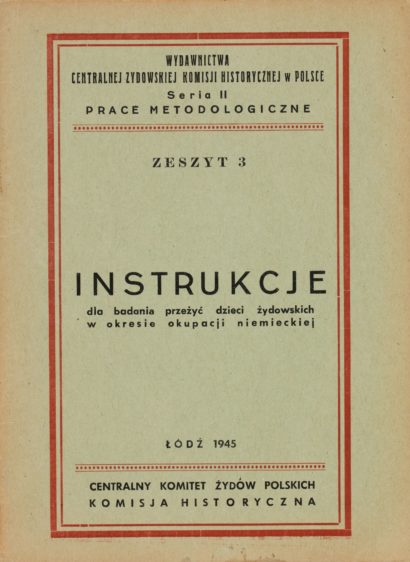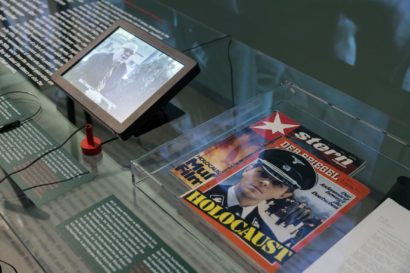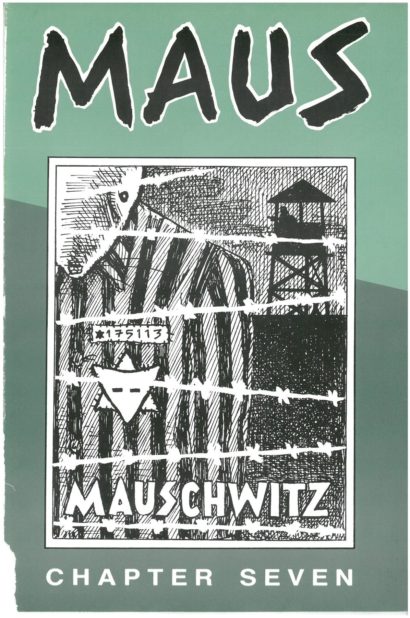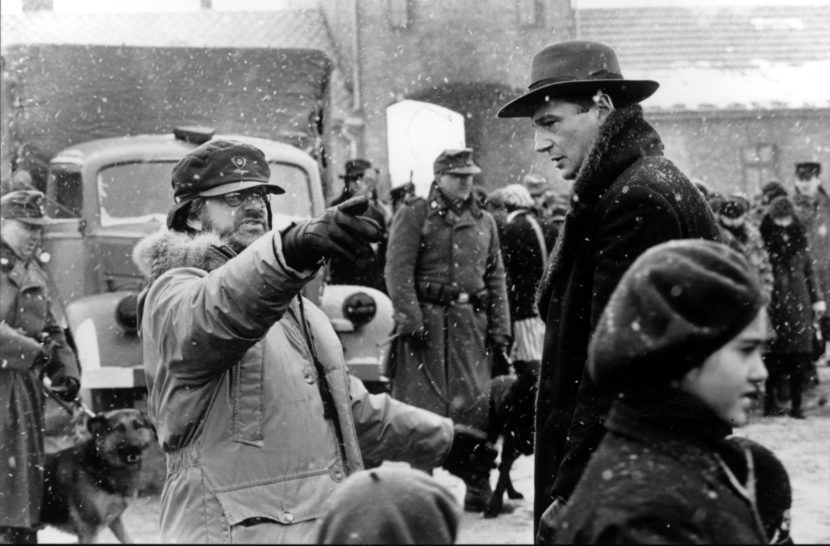The History of Contemporary Witnessing
Already before the end of World War II, the gathering and documenting of Holocaust survivors’ memories began. Since then, the role of contemporary witnesses as well as the function of their stories has been in a constant state of flux. Today it is hard to imagine the public perception without contemporary witnesses. However, this has not always been the case.
Early Documentation
Instructions for Interviews with witnesses, 1945; Emanuel Ringelblum Jewish Historical Institute, Warsaw
Instructions for Interviews was published by the Central Jewish Historical Commission (since 1947 Jewish Historical Institute in Warsaw). Holocaust survivors establish the commission in Lublin in 1944. They collect testimonies from survivors of the ghettos, concentration and extermination camps, together with memories of the destroyed Jewish communities, as well as evidence against Nazi perpetrators. To accomplish this task extensive guidelines are created to help deal with the traumatized former prisoners and partisans as well as children and adolescents.
Between 1944 and 1947 the Jewish Historical Institute interviews hundreds of survivors. These interviews lead to countless academic publications in Yiddish, Polish and Russian. It is only in the early 1990s that this body of research has started to draw international attention.
First Cinematic Accounts
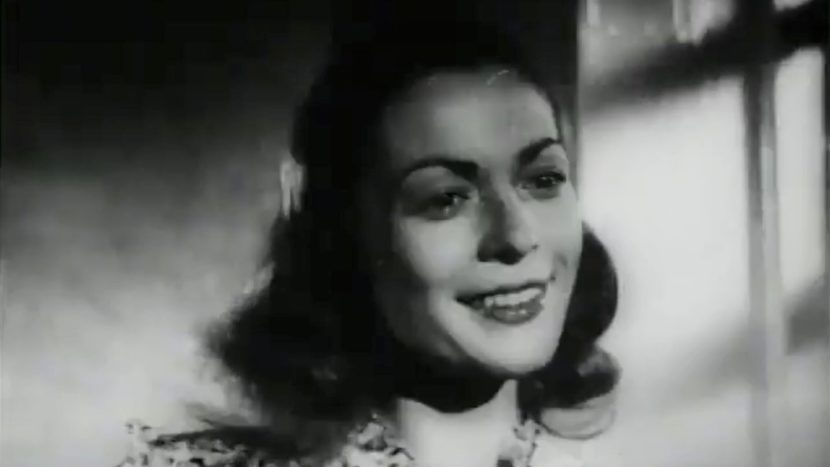
"Long is the Road", feature film, Germany 1948; National Center for Jewish Film, Brandeis University
„Long is the Road“ (Yiddish: Lang iz der veg) is the first film in post-war Germany to focus the fate of Jewish survivors and their living conditions after the war. To this day, this is the only German film produced in Yiddish language. The story evolves around the persecution of the Polish Jew David Jelin. After the war, he finds his mother, whom he believed to be dead, in the Landsberg DP camp, gets married and starts a family. The film, released in 1948, explicitly addresses the serious trauma of Holocaust survivors and, at the same time, suggests that any hope for a better future can only be in the not yet existing State of Israel.
The Polish-Jewish author and actor Israel Beker – who also writes the script – plays the role of David Jelin. After the war, Beker and other survivors found a Yiddish theatre group in the Landsberg DP camp. The experiences of the group members form the basis for the film. Above all, Beker’s escape from a train, through which he can save himself from persecution by the National Socialists, becomes a key scene in the film. However, filming in the Bavaria Studios is not always free of tension. Members of the local film crew were often bystanders or followers of the Nazi regime and prevent an explicitly Jewish perspective.
From Testimony to Contemporary Witnessing

Testimony Yehiel Dinur, Jerusalem, June 7, 1961; Yad Vashem, The World Holocaust Remembrance Center, Jerusalem / Israel State Archives, Jerusalem. Running time: 3:01 min
Adolf Eichmann’s trial in Jerusalem 1961 is a global event which is broadcasted worldwide. This trial stands out against previous court cases in Israel, and the Auschwitz trials that takes place in Frankfurt in the 1960s. For the first time the individual experiences of the witnesses take centre stage. Most of the witnesses have never met Eichmann in person.
The Eichmann trial thereby revisits the role of the witnesses: They do not testify to individual actions, instead their accounts serve to paint a general picture of the dimension of the National Socialist extermination policy. At the same time the role of the perpetrator is redefined: Eichmann is not found guilty for committing specific acts of crime, but for his role as the planner of the extermination of the European Jews.
On day 68 the trial sees the Israeli writer Yehiel Dinur, known under his pseudonym Ka-Tzetnik, In his testimony Dinur describes “Planet Auschwitz” and assumes the role of those murdered in the witness stand. At the end of his witness statement, Dinur collapses. His appearance at court is subject of much speculation: Were his testimony and the collapse staged to direct the public attention to the emotional strain of the witnesses or possibly Dinur’s own literary works?
"Holocaust" becomes a media event
"Der Spiegel" of January 29, 1979; JMH
In April 1978, the US-American channel NBC broadcasts its in house produced miniseries “Holocaust” for the first time. Using the fictitious example of the Jewish German family Weiss, the series tells the story of the exclusion, persecution and extermination of the European Jews between 1933 and 1945, whilst shining light on the central stages of the Holocaust. Blanche Baker, daughter of actress Carroll Baker and Flossenbürg survivor Jack Garfein, receives the Emmy Award as best supporting actress for her portrayal of Anna Weiss. The series is controversial. Amongst others, survivor Eli Wiesel accuses the NBC of having mainly commercial interests in mind and trivialising the suffering of the victims in a soap opera.
Already before the premiere of “Holocaust” in the Federal Republic of Germany in January 1979, the series causes fierce protests. Broadcasting the show is seen as an act of treason. Because of resistance in the board of the public-service broadcasters working group the series is not aired on their main channel ARD, but in regional channels. With more than 20 million viewers at times, “Holocaust” becomes a media event. In front of the TV, family members from different generations discuss topics such as by-standing, (not)knowing and responsibility during the Nazi regime. The series is particularly influential as it portrays the personal fates of the people persecuted, which until then did not generate a lot of interest on the side of the general public in West Germany.
Taking the lead, the regional channel WDR airs a discussion round, in which the viewers can ask questions. The channel receives more than 20,000 phone calls and a countless number of letters. The majority expresses shock about the magnitude of the Holocaust. However, there are also voices which doubt the truth of the events recounted in the series.
The Second and Third Generation
Art Spiegelman: Maus. A Survivor’s Tale. Chapter Seven (initial publication), in: RAW, no. 8, 1982; Ole Frahm, Frankfurt a.M.
The graphic novel Maus by Art Spiegelman is published in a series of episodes in the comic magazine Raw between 1980 and 1991 and narrates the story of the author’s father, a Holocaust survivor. Besides retelling his father’s experiences during the Holocaust, Spiegelman also illustrates the burden descendants of Holocaust survivors feel by the stories of their parents.
During the 1980s, children and grandchildren of survivors begin to reflect critically on the fate of their parents and grandparents and start questioning their own identity. These debates mark the start of early reflection about the death of eye witnesses and the question if and how the contemporary witnesses’ legacy will be continued by the following generations.
Memorial Boom
Schindler’s List, feature film by Steven Spielberg, 1993; Ronald Grant Archives / Mary Evans / picturedesk.com
This photo is taken during the filming of Schindler’s List in Poland and shows Steven Spielberg together with the actor Liam Neeson, who plays Oskar Schindler. When the movie comes out in 1993, it sparks a true “memorial boom”. Countless Holocaust survivors write down their memoirs. These memoirs in turn cause the creation of numerous movies, TV-documentaries and contemporary witness interview recordings.
An ever-growing audience is expecting ever more emotional and authentic stories of survivors. At the same time the eye witnesses accept and use this public willingness to listen and begin to enter the stage. The USC Shoah foundation, financed by the revenue of Schindler’s List, is one of the organisations conducting and recording contemporary witness interviews. They become frequent and well-loved guests in talk shows and other TV formats. Victim groups, such as Sinti and Roma, homosexuals and forced labourers, who were neglected in the four decades prior, are now able to publicly talk about their experiences as well.
More Objects
Please find more objectes and background stories on contemporary witnessing on our social media.
